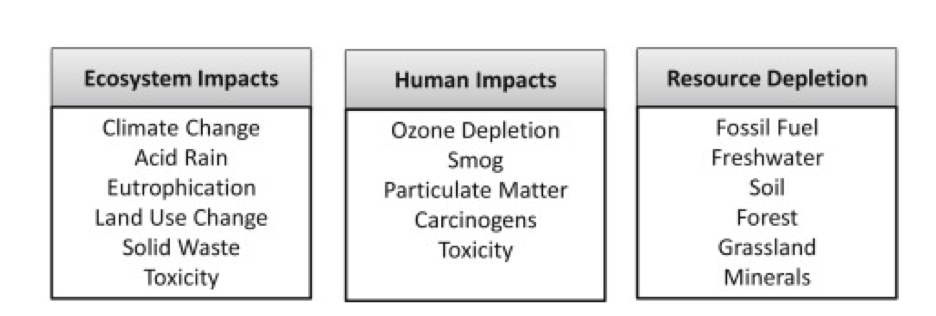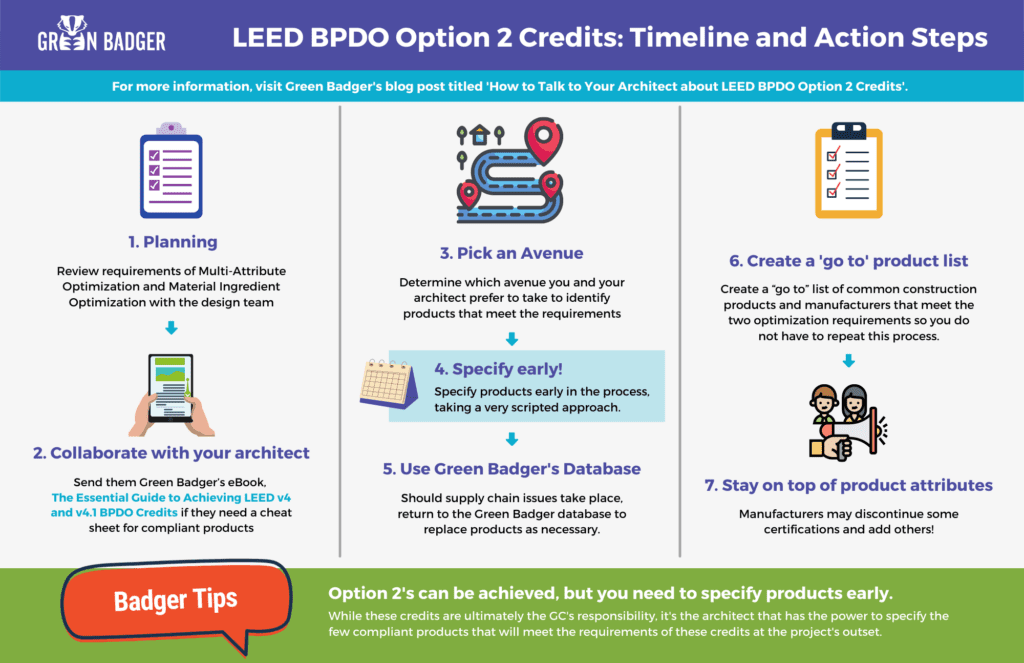
by Lauren Richardson
Sustainability Associate at Green Badger
GBCI Pro Reviewer
The problem with the LEED BPDO Option 2 Credits is that, while they can be achieved, your team really needs to specify which products are going to be used from the beginning of the project in order to achieve them.
More and more project teams are seeing Option 2 credits being assigned on their LEED scorecards. While these credits are ultimately the contractor’s responsibility to achieve as LEED construction credits, it’s the architect that has the power to specify the few compliant products that will meet the requirements of these credits at the project’s outset.
There are so few products that comply with these Option 2 requirements that general contractors and architects need to work together in order to earn these credits. If you want to know what these products are, download Green Badger’s Essential Guide to the LEED BPDO Credits – it’s a life saver! The credits we’ll be covering in this post are LEED Building Product Disclosure and Optimization credits with Option 2’s are MRc2 Option 2 Multi-Attribute Optimization and MRc4 Option 2 Material Ingredient Optimization, both of which Green Badger has dedicated eBooks for showing construction project teams how to achieve them!

What is the intent of the BPDO credits?
As outlined by USGBC and GBCI, “The intent of the Building Product Disclosure and Optimization credits (BPDO) in LEED v4 is to encourage adoption of products that disclose and ultimately optimize full life-cycle impacts, including impacts of raw material sourcing and effects on human health.”
There are three distinct credits that get grouped together in the Building Product Disclosure and Optimization (BPDO) category. These are the Environmental Product Declarations (EPD) credit, the Sourcing of Raw Materials (Sourcing) credit and the Material Ingredients (Material Ingredients) credit. In addition to these, the Low-Emitting Materials credit under Indoor Environmental Quality has also undergone revision and finds significant overlaps in product categories with the BPDO credits, but has it’s own unique challenges.
This is the intent of the LEED BPDO credits as outlined by USGBC:
- To encourage design-build team to use products and materials that have life-cycle information available.
- To encourage design-build team to use products and materials that are better for the environment.
- To reward design-build teams for using products that minimize the use of harmful ingredients.
- To reward manufacturers for producing products that have improved life-cycle impacts and transparency of ingredients, showing a commitment to sustainability.
- To encourage the manufacture and use of products that disclose contents and optimize life cycle impacts, including impacts of raw material sourcing and effects on human health.
Bellow you’ll find Green Badger’s recommendations for achieving each of the BPDO Option 2 credits, with different avenues your team could take.

Requirements for MRc2 Option 2 Multi-Attribute Optimization
Under LEED v4.1 update, teams are required to use at least 5 permanently installed products that comply with one of the criteria above from 3 different manufacturers. This is much more achievable than the requirements under LEED v4, but you still need to specify which products to use early on since there are so few on the market that comply (as of April 2022).
- Life Cycle Impact Reduction Action Plan (value at 50% by cost or ½ product)
- Life Cycle Impact Reductions in Embodied Carbon (value at 100% by cost or 1 product)
- Life Cycle Impact Reductions in Embodied Carbon – 10% reduction global warming potential (value at 150% by cost or 1.5 products)
- Life Cycle Impact Reductions in Embodied Carbon – 20% reduction in global warming potential and 5% reduction 2 other impact categories (value at 200% by cost or 2 products)
A life cycle analysis (LCA), also known as life cycle assessment, is a measure of sustainability that evaluates the environmental burden of a product throughout its entire life span. Sometimes referred to as a “cradle-to-grave” assessment, it compiles inventory of relevant energy and material inputs and environmental releases.
Examples of Life Cycle Impact
These are examples of life cycle impact categories.


Life Cycle Reduction Requirements
These are the requirements for lifecycle impact reduction that need to be show for a specific product value under the requirements for MRc2 Option 2 Multi-Attribute Optimization.




Avenues to Achieving MRc2 Option 2 Multi-Attribute Optimization
Here are a few different directions your team could take when trying to achieve this credit.



Avenue A to Achieving MRc2 Option 2 Multi-Attribute Optimization
Step 1:
Call Green Badger and purchase a software license for the duration of your project. Green Badger has all of these products in our database, along with the required compliance information.
Step 2:
Connect with your architect and suggest that these products be used on your project to achieve the credit.



Download the MRc2 Option 2 Multi-Attribute Optimization eBook to find the products that comply with the requirements, and then use the database to automatically document them for your project.






Avenue B to Achieving MRc2 Option 2 Multi-Attribute Optimization
Step 1:
Use the finish schedule created by your architect and determine if any of the products on the project meet the requirements.
Step 1:
Collaborate with you architect to see if they are willing to change any of the products to earn the credit.



Avenue C to Achieving MRc2 Option 2 Multi-Attribute Optimization
Step 1:
Request Material Ingredient documentation from product manufacturers you trust and with whom you have a relationship. This avenue is what will drive the marketplace the most. They might not get documentation for your current LEED project, but again, keeping the long view in mind, this is a great option.
Step 2:
Specify products that currently meet the requirements in case your manufacturer does not obtain documentation in time.



Requirements for MRc4 Option 2 Material Ingredient Optimization
Under LEED v4.1 you can earn 1 point for your project by using 5 products across 3 manufacturers. Take a scripted approach from Cradle-to-Cradle certified products and compliant Declare labels.
- Material Ingredient Screening and Optimization Action Plan (value ½ product)
- Advanced Inventory & Assessment (value 1 product)
- Material Ingredient Optimization (value 1.5 products)
What qualifies as an Advanced Inventory & Assessment?
- Declare labels designated as Red List Free that are third-party verified
- Living Product Challenge certified products that include a Red List Free Declare label
- Cradle to Cradle: Product has Material Health Certificate or is Cradle to Cradle Certified™ under standard version 3 or later with a Material Health achievement level at the Bronze level or higher
What qualifies as Material Ingredient Optimization?
- The product needs a third-party verified HPD that was inventoried to 100 ppm with no Benchmark 1 or LT-1 hazards AND 95% by weight assessed using the GreenScreen Benchmark.
- Cradle to Cradle Certification: Product has Material Health Certificate or is Cradle to Cradle Certified™ under standard version 3 or later with a Material Health achievement level at the Silver level or higher.
- Living Product Challenge Certification: Products certified to the Living Product Challenge which includes achievement of Imperative 09: Transparent Material Health


Avenues to achieving MRc4 Option 2 Material Ingredient Optimization
Here are a few different directions your team could take when trying to achieve this credit.



Avenue A to achieving MRc4 Option 2 Material Ingredient Optimization
Step 1:
The same project license to achieve MRc2 Option 2 will allow you to earn MRc4 Option 2. Green Badger’s database has dozens of Cradle to Cradle, Declare, and Health Product Declarations that meet the requirements, along with the required compliance information.
Step 2:
Connect with your architect and suggest that these products be used on your project to achieve the credit.



Download the MRc4 Option 2 Material Ingredient Optimization eBook to find the products that comply with the requirements, and then use the database to automatically document them for your project.






Avenue B to achieving MRc4 Option 2 Material Ingredient Optimization
Step 1:
Use your architects product list to check their attributes in Green Badger’s database.
Step 2:
Suggest products from Green Badger’s database to augment or replace the architect’s products that don’t meet the requirements.



Avenue C to achieving MRc4 Option 2 Material Ingredient Optimization
Step 1:
Determine the general product categories required for the project.
Step 2:
Review websites for Declare labels, Health Product Declarations, and Cradle to Cradle certified products.
Step 3:
Create a product list of required products with the necessary characteristics.


Avenue D to achieving MRc4 Option 2 Material Ingredient Optimization
Step 1:
Request Material Ingredient documentation that meets the Optimization requirements from product manufacturers you trust and with whom you have a relationship. Again, this is for the long haul.
Step 2:
Follow Avenue A, B, or C to Specify products that currently meet the requirements in case your manufacturer does not obtain documentation in time.


Timeline and Action Steps
- Review requirements of MRc2 Option 2 Multi-Attribute Optimization and MRc4 Option 2 Material Ingredient Optimization with the design team
- Collaborate with your architect – send them Green Badger’s eBook Essential Guide to LEED BPDO Credits if they need a cheat sheet for compliant products
- Determine which avenue you and your architect prefer to take to identify products that meet the requirements
- Specify products early in the process, taking a very scripted approach
- Should supply chain issues take place, return to the Green Badger database or your own research avenues to replace products as necessary
- Create a “go to” list of common construction products and manufacturers that meet the two optimization requirements so you do not have to repeat this process
- Stay on top of product attributes – manufacturers may discontinue some certifications and add others!
LEED is fluid and changing to adapt to its users!
Give USGBC your feedback! They do listen and revise their requirements. In fact, they just published the results from 2021 survey. Let them know that this is a requirement that is difficult to achieve – architects must take over a construction credit or general contractors must adjust architect specifications. LEED might revise these particular requirements to achieve the intent in a way that is more realistic in view of the actual design-build process. For more details on what this entails visit our Ultimate Guide to LEED v4 and v4.1 Construction Credits or take Green Badger Academy, for $79 per user.






Hello, I have a question regarding MRC4 option 2, specifically the advanced inventory and assessment: the LEED v4.1 requirements mention what is required is inventory to at least .01 (100 ppm) and no LT-1 or GHS category 1 hazards. If I have a RedList free declare label for a product to 100ppm, would I need additional documentation to prove its LT-1 or GHS free, or does red list free also mean that it wont be containing any LT-1 or GHS hazards?
Thanks,